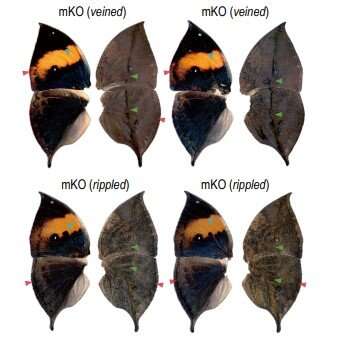Scientists now understand the genetics responsible for leaf mimicry in butterfly wings

The top side of the Kallima butterfly's wings are brightly colored, featuring vibrant bands of deep blue, black, and orange. But when this butterfly flaps its wings, the undersides reveal a sharp contrast—they are shades of dull brown that perfectly mimic a dead leaf, camouflaging the butterflies from predators. In research published in the journal Cell on August 1, scientists discover which gene is responsible for leaf mimicry in Kallima butterflies and discuss what it means for our understanding of their evolution.
"Butterfly wings have relatively simple structures, but this simple structure is responsible for some very complex functions: locomotion, thermoregulation, mate preference, and predator avoidance," says Wei Zhang, a butterfly researcher at Peking University in China. "Because these wings are structurally simple but functionally complex, I think butterfly wings are the ideal system to address multiple evolutionary questions."
In order to understand the evolution and genetics responsible for the oak leaf butterfly's exceptional ability to disguise itself, the team collected Kallima samples from 36 different genera across Asia. They then sequenced these butterfly's genomes and homed in on one gene, named cortex, that appeared to be responsible for the varying leaf patterns.
Evolutionary pressures on this gene drive interesting morphological changes across the butterfly's population. "This leaf wing polymorphism has been maintained in multiple Kallima species, but different species may have different phenotype frequencies," says Zhang. "I think this is due to the proliferation of specific plants in particular habitats, so the butterflies will gain more protective benefits by having different frequencies of wing phenotypes."
The team focused on one region, the eastern Himalayas, as a hub for diversification in Kallima butterflies. Because they found so much variation in this area, they were able to examine the evolution on a smaller scale than usual. "We generally focus on biodiversity at a macroevolutionary level," says Zhang. "But we seldom have cases that illustrate in detail how species diversity and genetic diversity originated in such a diversity hotspot."
In the future, Zhang and her team intend to continue to examine how wing coloration and patterns vary in different regions and with different plant life. "We would like to understand how these genes facilitate, and originated, such beautiful diversifying wing patterns," she says.
More information: Wei Zhang, The evolution and diversification of oakleaf butterflies, Cell (2022). DOI: 10.1016/j.cell.2022.06.042. www.cell.com/cell/fulltext/S0092-8674(22)00794-2
Journal information: Cell
Provided by Cell Press




















